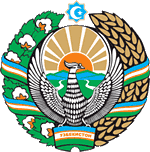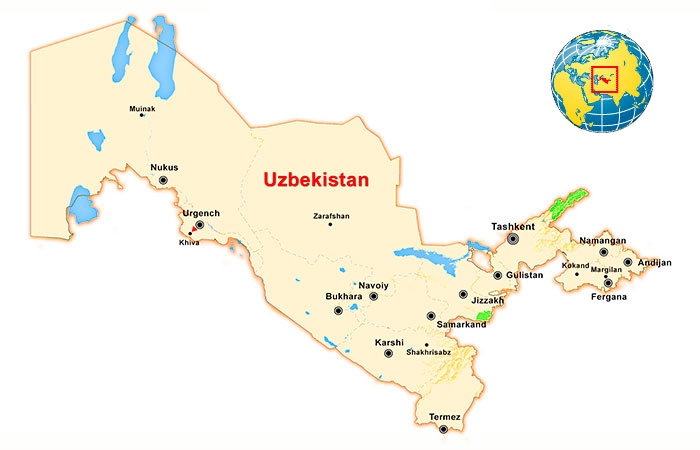Uzbekistan
Official name: Republic of Uzbekistan
Area:447,400 km2
Population: 5,895,100 people (2015 estimate)
Capital: Tashkent
Official language: Uzbek
Government:Presidential Republic
President: Shavkat Mirziyoyev
Religion: Islam, Russian Orthodoxy
Currency: Sum (UZS)
Time Zone: UTC (UTC+5)
Drives: on the right
Bank opening days: Monday - Friday
Electrical power: 220 V AC, 50 A (standard 2-pin socket)
Telephone code: +998
Internet TLD:.uz

Flag

Emblema

Map
Uzbekistan is a doubly landlocked country in Central Asia and one of the six independent Turkic states. It shares borders with Kazakhstan to the west and to the north, Kyrgyzstan and Tajikistan to the east, and Afghanistan and Turkmenistan to the south. Most of Uzbekistan’s population today belong to the Uzbek ethnic group and speak the Uzbek language, one of the families of Turkic languages.
Geography
Uzbekistan has an area of 447,400 square kilometers (172,700 sq mi). It is the 56th largest country in the world by area and the 42nd by population. Among the CIS countries, it is the 5th largest by area and the 3rd largest by population. Uzbekistan lies between latitudes 37° and 46° N, and longitudes 56° and 74° E. It stretches 1,425 kilometers (885 mi) from west to east and 930 kilometers (580 mi) from north to south. Bordering Kazakhstan and the Aral Sea to the north and northwest, Turkmenistan to the southwest, Tajikistan to the southeast, and Kyrgyzstan to the northeast, Uzbekistan is not only one of the larger Central Asian states but also the only Central GeographyAsian state to border all the other four. Uzbekistan also shares a short border (less than 150 km or 93 mi) with Afghanistan to the south.
Provinces and districts
Uzbekistan is divided into twelve provinces, one autonomous republic (Karakalpakistan Autonomous Republic), and one independent city (Toshkent city).
Demographics
Uzbekistan is Central Asia's most populous country. Its 28.1 million people (July 2011 estimate) comprise nearly half the region's total population. The population of Uzbekistan is very young: 34.1% of its people are younger than 14 (2008 estimate).According to official sources, Uzbeks comprise a majority (80%) of the total population. Other ethnic groups include Russians 5.5%, Tajiks 5% (official estimate and disputed), Kazakhs 3%, Karakalpaks 2.5% and Tatars 1.5%
Religion
Islam is by far the dominant religion in Uzbekistan, as Muslims constitute 90% of the population while 5% of the population follows Russian Orthodox Christianity, and 5% of the population follows other religion according to a 2009 US State Department release.
Languages
The Uzbek language is the only official state language, and since 1992 is officially written in Latin alphabet. Russian is an important language for interethnic communication, especially in the cities, including much day-to-day technical, scientific, governmental and business use. Russian is the main language of over 14% of the population and is spoken as a second language by many more.
Holidays
January 1 - New Year
January 14 - Military Day
March 8 - International Women's Day
March 21 - Navruz
May 9 - Remembrance Day
September 1 - Independence Day
October 1 - Teacher's Day
December 8 - "Constitution Day"
Variable date
End of Ramazon Ramazon Hayit Eid al-Fitr 70 days later Qurbon Hayit Eid al-Adha
Rivers and lakes
Uzbekistan generally lies between the two largest rivers of Central Asia, the Amu Darya and Syr Darya. These two roughly parallel rivers both have their headwaters in the mountains east of Uzbekistan and follow northwesterly courses toward the Aral Sea, a saltwater lake straddling the border between Uzbekistan and Kazakhstan. Since the early 1960s the Aral Sea has shrunk to less than half its former size, and dry land has separated the remaining water into two main lakes. Uzbekistan’s largest river is the Amu Darya. This river is formed by the confluence of the Panj and Vakhsh rivers on the extreme southwestern border of Tajikistan, near the southeastern tip of Uzbekistan. The Amu Darya traverses a course generally parallel to, and at times part of, Uzbekistan’s southern borders with Afghanistan and Turkmenistan, then turns due north through Uzbekistan’s Qoraqalpogh Autonomous Republic toward the southern section of the Aral Sea. The Syr Darya is formed in the fertile Fergana (Farghona) Valley by the convergence of two rivers flowing from the east, the Naryn and Qoradaryo. The Syr Darya then flows westward through this valley and northern Tajikistan, turns north to cut through Uzbekistan, and enters Kazakhstan, eventually reaching the northern section of the Aral Sea. Another important river is the Zeravshan, which flows westward from the mountains of Tajikistan through east central Uzbekistan. Before it began to be tapped for irrigation, the Zeravshan was the Amu Darya’s largest tributary; now it dissipates in the Qyzylqum desert near the city of Bukhara (Bukhoro). Uzbekistan has thousands of small streams that expire in the desert, many having been emptied by irrigation. Extensive canal systems, such as the Amu-Bukhara canal and many others built during the Soviet period, have greatly altered water-flow patterns. Artificial lakes and reservoirs have been created, many of which are fed by irrigation runoff. The largest freshwater lake is Lake Aydarkul, in northeastern Uzbekistan. Aydarkul Lake. Deserts and steppes create the picturesque landscape of Uzbekistan. The widely spread plants are full with wormwood bitter and acacia. Large forest tracts are absent. Flora and fauna are diverse. The animal world consist as revealed of 40 kinds of mammals, 60 kinds of reptiles, 74 kinds of fishes, 68 kinds of trees and 3 000 kinds of grasses. The most spread mammals are wild sheep, noble deer, gazelles and saigaks. Main predators are brown bear, wolf, panther and lynx.
Deserts
Karakum is the largest desert region of Central Asia with an extent of about 350.000 km. and Kyzyl Kum with an area of 300.000 km. In the south the small part of the desert of Karakum which is in translation indicates “black sand” belongs to Uzbekistan. Sand, however, is not black, since the word “kara (black)” also indicates “dangerous”. On the north lies the desert Kyzyl Kum, “red sand”, which stretches between the rivers Amu-Dar'ya and Syrdarya. Desert in the specific hours actually seems reddish. Both deserts are not purely sandy deserts, they are covered with plants. Since in the Central-Asian deserts per year falls out to 200 mm of sediments, predominantly in spring, subsoil of both deserts not waterless. This can be felt especially in March, when the carpet from the grasses, which consists, of sedge, tamarisks and bushes of saxsaul begin to blossom. In the deserts herbivorous reptiles live in essence: lizard, monitor lizards, snake. If it goes lucky, it is possible
